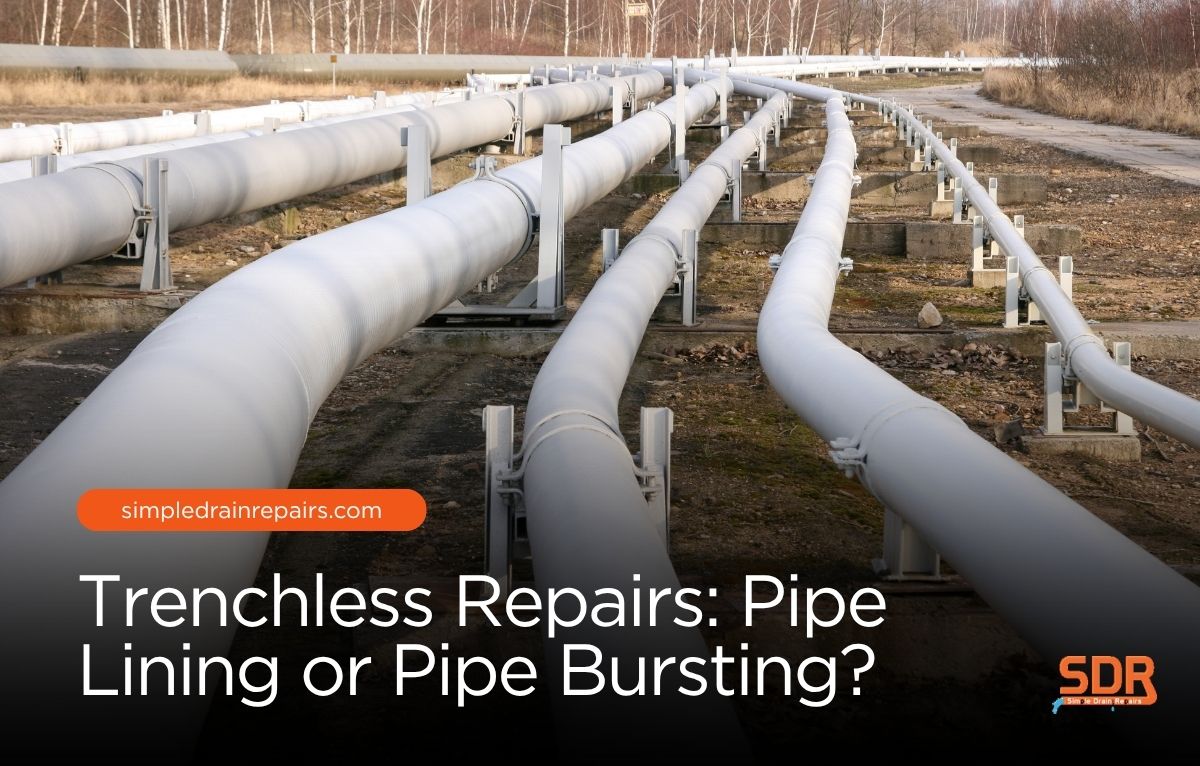
When sewer or drain lines start to fail, homeowners and property managers often assume excavation is their only option. But trenchless methods have changed that.
Two of the most common techniques used today are pipe lining and pipe bursting. Each one offers a modern solution with distinct benefits depending on the condition of the existing pipe and what the property allows.
Knowing the right method for your situation can mean faster service, less mess, and long-term peace of mind. Here’s what to know when comparing pipe bursting vs pipe lining.
Pipe lining, also called CIPP (Cured-in-Place Pipe), works by creating a new pipe inside the old one. It’s ideal for sewer and drain lines that are structurally intact but may have cracks, corrosion, or moderate root intrusion.
The process involves inserting a resin-coated liner into the damaged pipe. This liner is then inflated and allowed to cure in place, forming a smooth, jointless new interior.
This method is often used when digging up landscaping, driveways, or foundations is too disruptive. It’s a preferred option for residential homes or commercial buildings where minimizing noise and surface access matters.
The finished liner is durable and resistant to future corrosion or leaks, giving the old pipe new life with minimal hassle.
Pipe bursting, by contrast, replaces the old pipe completely. It’s most useful when the existing pipe has collapsed, shifted, or deteriorated to the point where lining wouldn’t hold.
Using a specialized bursting head, technicians break apart the old pipe and pull a new one into the same space. One major advantage is that it allows for upsizing.
If the original pipe was too narrow for current needs, pipe bursting can install a larger diameter line. It does require access points at both ends of the damaged pipe and enough room in the surrounding soil to accommodate the bursting process.
This method is common for full sewer line replacements and often used in older homes where materials like clay or Orangeburg were originally installed. It provides a completely new pipe that meets modern standards for flow and durability.
There are specific cases where pipe lining is the better choice. If the pipe still holds its shape but has leaks or cracks, or if root intrusion is present but manageable, pipe lining can solve the issue without major disruption.
It’s also a good fit when the damaged area runs under a structure or hard-to-reach location. For homeowners who want to preserve landscaping or surface features, lining avoids heavy machinery and can often be completed in just one day.
Pipe bursting works well in cases where the pipe has fully collapsed or shows extreme corrosion. It also becomes the preferred option when the layout allows for equipment access at both ends or when there’s a need to increase the diameter for improved flow.
If the pipe material isn’t compatible with lining methods, bursting is the more effective route. Though it requires more setup, this method eliminates the problems caused by deteriorated pipe materials and results in a fully replaced system.
No repair method fits every situation. Both pipe lining and pipe bursting come with strengths and a few limitations. Here’s a comparison to help clarify:
Pipe Lining Pros:
Pipe Bursting Pros:
Despite these benefits, pipe lining can’t be used on pipes that are misshaped or collapsed. It slightly reduces internal diameter and may not work well with all materials.
Pipe bursting, on the other hand, requires two access points and clearance in the surrounding soil, and can be more labor-intensive.
The condition of your current pipe is the biggest factor. If it’s still intact and the damage is limited to surface cracks or leaks, lining is often more efficient.
If the pipe is broken down beyond use, bursting will likely be the better call. Also consider your property layout.
If your lines run under large trees, patios, or building structures, pipe lining may cause less disruption. But if the existing pipe is no longer serving its purpose or you plan on upgrading plumbing flow, pipe bursting brings lasting value.
Another key point: always start with a thorough camera inspection. This provides an accurate view of the problem and helps determine which solution makes the most sense. Guesswork leads to wasted time and budget.
When weighing pipe bursting vs pipe lining, it comes down to the health of your existing line and how much disruption your property can handle. Both offer strong alternatives to traditional excavation and can extend the life of your sewer or drain system for decades.
For severe structural failure, pipe bursting often wins. For smaller issues and limited access areas, lining is quicker and less intrusive.
Simple Drain Repairs offers both pipe bursting and pipe lining across New Jersey. Our team provides video inspections, diagnostics, and trenchless repairs for homes and businesses. Let us help you choose the right method with professional insight and guaranteed workmanship.